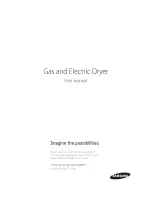
SV9401/SV9402/SV9403, SV9501/SV9502/SV9503, SV9601/SV9602 SMARTVALVE™ SYSTEM CONTROLS
69-1004—2
10
4.
With the main burner in operation, paint the pipe
joints (including adapters) and the control inlet and
outlet with rich soap and water solution.
5.
If another leak is detected, tighten the adapter
screws, joints, and pipe connections.
6.
Replace the part if a leak cannot be stopped.
Check and Adjust Pilot Flame
The pilot flame should envelop 3/8 to 1/2 in. (10 to 13
mm) of the tip of the flame rod. It should also be in
continual contact with the ground electrode. See Fig. 12.
If the pilot flame is small or lazy, or does not touch the
ground electrode, the inlet gas pressure may be to low,
or the pilot orifice may be partially clogged. Check and
repair as necessary. If the pilot flame is hard and noisy,
the inlet gas pressure may be too high. The ignition
system control has a pilot adjustment mechanism to
reduce the pilot flow, if necessary. Use the following
procedure:
1.
1.Remove pilot adjustment cover screw. See Fig.
4.
NOTE: Pilot adjustment is shipped at full flow rate.
2.
Turn the inner adjustment screw clockwise if the
inlet pressure is too high.
NOTE: If the adjustment screw is used to reduce pilot
flow rate, the pilot flame can become too small
for reliable system operation if the system inlet
pressure drops significantly.
3.
Replace the cover screw after the adjustment to
prevent gas leakage.
Fig. 12. Proper flame adjustment.
Check and Adjust Gas Input and Burner
Ignition
IMPORTANT
1. Do not exceed input rating stamped on the
appliance nameplate.
2. Do not exceed manufacturers recommended
burner orifice.
3. Make certain primary air supply to main burner
is adjusted properly for complete combustion.
4. Follow appliance manufacturer instructions.
Checking Gas Input by Clocking Gas
Meter
IMPORTANT
1. Make sure there is no gas flow through the
meter except to the appliance being checked.
Other appliances must remain off with their pilot
lights extinguished. Otherwise, subtract that
usage from the meter reading.
2. Convert the flow rate to Btuh as described in
Gas Controls Handbook, form 70-2602.1.Make
sure there is no gas flow through the meter
except to the appliance being checked. Other
appliances must remain off with their pilot lights
extinguished. Otherwise, subtract that usage
from the meter reading.
3. Compare actual Btuh to the input rate on the
appliance nameplate.
Checking Gas Input with Manometer
IMPORTANT
1. Make sure the ignition system control is in the
OFF position before removing outlet pressure
tap plug to connect manometer (pressure
gauge).
2. Shut off gas supply at the manual valve in the
gas piping to the appliance or, for LP, at the
tank.
3. Move the ignition system control switch to the
OFF position when removing the gauge and
replacing the plug.
4. Remove inlet pressure tap plug.
5. Shut off gas supply.
6. Disconnect manometer and replace plug.
7. Repeat Gas Leak Test at plug with main burner
operating.
NOTE: Check the inlet pressure before adjusting the
pressure regulator.
Standard (M) and Slow-Opening (H)
Pressure Regulator Models
1.
Carefully check the main burner lightoff to make
sure the burner lights smoothly and all the ports
remain lit.
2.
Check the full rate manifold pressure listed on the
appliance nameplate. The ignition system control
full rate outlet pressure should match this rating.
3.
With the main burner operating, check the ignition
system control flow using the meter clocking
method or check pressure using a manometer
connected to the output pressure tap on the
ignition system control.
4.
Adjust the pressure regulator (if necessary) to
match the appliance rating. See Tables 8 and 9 for
factory set nominal outlet pressure and adjustment
range.
a. Remove the pressure regulator adjustment cap
screw.
b. Using a screwdriver, turn the inner adjustment
screw clockwise to increase or
counterclockwise to decrease the gas pressure
to the burner.
c. Replace the cap screw and tighten firmly to
prevent gas leakage.
PROPER FLAME
ADJUSTMENT
HOT SURFACE
IGNITER
FLAME ROD
M3350A
GROUND
ELECTRODE
3/8 TO 1/2 IN.
(10 TO 13 MM)
NOTE: GROUND ELECTRODE MUST NOT TOUCH FLAME
ROD (.050 IN. MINIMUM CLEARANCE). BEND GROUND
ELECTRODE IF NECESSARY. DO NOT BEND FLAME ROD.
69-1004-2.fm Page 10 Wednesday, November 5, 2003 10:49 AM








































